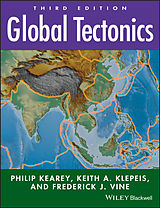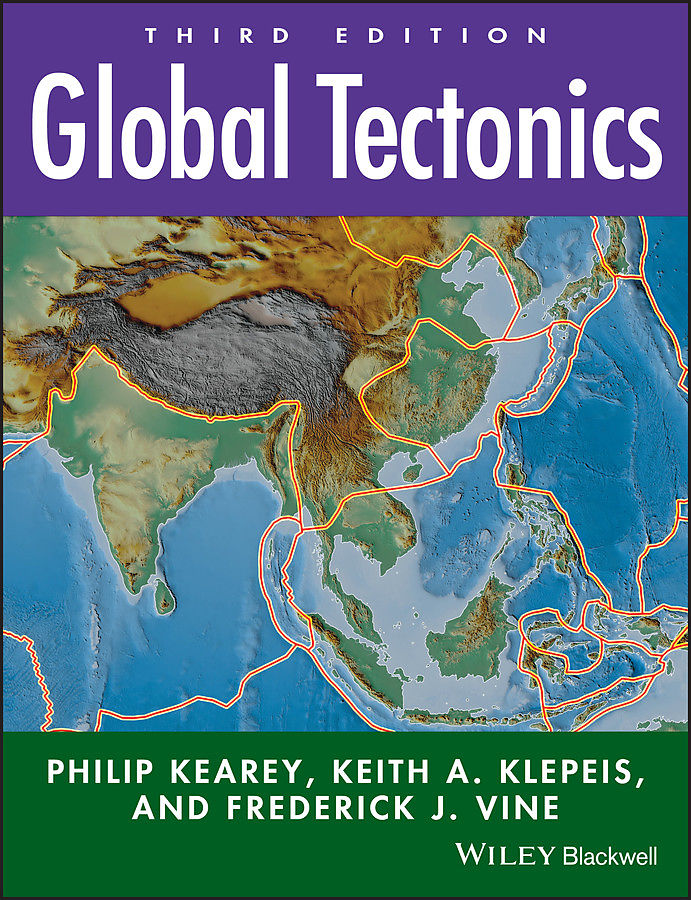Global Tectonics
Einband:
E-Book (pdf)
EAN:
9781444303223
Autor:
Philip Kearey, Keith A. Klepeis, Frederick J. Vine
Herausgeber:
Wiley-Blackwell
Erscheinungsdatum:
26.01.2009
The third edition of this widely acclaimed textbook provides a comprehensive introduction to all aspects of global tectonics, and includes major revisions to reflect the most significant recent advances in the field. * A fully revised third edition of this highly acclaimed text written by eminent authors including one of the pioneers of plate tectonic theory * Major revisions to this new edition reflect the most significant recent advances in the field, including new and expanded chapters on Precambrian tectonics and the supercontinent cycle and the implications of plate tectonics for environmental change * Combines a historical approach with process science to provide a careful balance between geological and geophysical material in both continental and oceanic regimes * Dedicated website available at href="http://www.blackwellpublishing.com/kearey/">www.blackwellpublishing.com/kearey/
Autorentext
PHIL KEAREY was Senior Lecturer in Applied Geophysics in the Department of Earth Sciences at Bristol University, U.K. prior to his premature death in 2003. In his research he used various types of geophysical data, but gravity and magnetic data in particular, to elucidate crustal structure in the eastern Caribbean, Canadian shield and southern England. KEITH KLEPEIS is a Professor in the Department of Geology at the University of Vermont, U.S.A. He specializes in the areas of structural geology and continental tectonics and has worked extensively on the evolution of orogenic belts and fault systems in New Zealand, Patagonia, West Antarctica, Australia, British Columbia and southeast Alaska. FREDERICK J. VINE is an Emeritus Professor in the School of Environmental Sciences at the University of East Anglia, Norwich, U.K. He was made a Fellow of the Royal Society of London and has received numerous awards for work on the interpretation of oceanic magnetic anomalies and ophiolites, fragments of oceanic crust thrust up on land, in terms of sea floor spreading.
Inhalt
Preface ix Acknowledgments x The geologic timescale and stratigraphic column xi 1 Historical perspective 1 1.1 Continental drift 2 1.2 Sea floor spreading and the birth of plate tectonics 6 1.3 Geosynclinal theory 7 1.4 Impact of plate tectonics 8 2 The interior of the Earth 9 2.1 Earthquake seismology 10 2.1.1 Introduction 10 2.1.2 Earthquake descriptors 10 2.1.3 Seismic waves 10 2.1.4 Earthquake location 11 2.1.5 Mechanism of earthquakes 12 2.1.6 Focal mechanism solutions of earthquakes 12 2.1.7 Ambiguity in focal mechanism solutions 14 2.1.8 Seismic tomography 17 2.2 Velocity structure of the Earth 19 2.3 Composition of the Earth 21 2.4 The crust 22 2.4.1 The continental crust 22 2.4.2 Upper continental crust 23 2.4.3 Middle and lower continental crust 23 2.4.4 The oceanic crust 24 2.4.5 Oceanic layer 1 24 2.4.6 Oceanic layer 2 25 2.4.7 Oceanic layer 3 26 2.5 Ophiolites 27 2.6 Metamorphism of oceanic crust 28 2.7 Differences between continental and oceanic crust 29 2.8 The mantle 30 2.8.1 Introduction 30 2.8.2 Seismic structure of the mantle 30 2.8.3 Mantle composition 31 2.8.4 The mantle low velocity zone 31 2.8.5 The mantle transition zone 32 2.8.6 The lower mantle 32 2.9 The core 33 2.10 Rheology of the crust and mantle 33 2.10.1 Introduction 33 2.10.2 Brittle deformation 34 2.10.3 Ductile deformation 36 2.10.4 Lithospheric strength profiles 37 2.10.5 Measuring continental deformation 39 2.10.6 Deformation in the mantle 41 2.11 Isostasy 42 2.11.1 Introduction 42 2.11.2 Airy's hypothesis 43 2.11.3 Pratt's hypothesis 43 2.11.4 Flexure of the lithosphere 44 2.11.5 Isostatic rebound 45 2.11.6 Tests of isostasy 46 2.12 Lithosphere and asthenosphere 48 2.13 Terrestrial heat flow 51 3 Continental drift 54 3.1 Introduction 55 3.2 Continental reconstructions 55 3.2.1 Euler's theorem 55 3.2.2 Geometric reconstructions of continents 55 3.2.3 The reconstruction of continents around the Atlantic 56 3.2.4 The reconstruction of Gondwana 57 3.3 Geologic evidence for continental drift 58 3.4 Paleoclimatology 60 3.5 Paleontologic evidence for continental drift 61 3.6 Paleomagnetism 64 3.6.1 Introduction 64 3.6.2 Rock magnetism 64 3.6.3 Natural remanent magnetization 65 3.6.4 The past and present geomagnetic field 66 3.6.5 Apparent polar wander curves 67 3.6.6 Paleogeographic reconstructions based on paleomagnetism 68 4 Sea floor spreading and transform faults 72 4.1 Sea floor spreading 73 4.1.1 Introduction 73 4.1.2 Marine magnetic anomalies 73 4.1.3 Geomagnetic reversals 74 4.1.4 Sea floor spreading 77 4.1.5 The Vine-Matthews hypothesis 78 4.1.6 Magnetostratigraphy 79 4.1.7 Dating the ocean floor 84 4.2 Transform faults 84 4.2.1 Introduction 84 4.2.2 Ridge-ridge transform faults 88 4.2.3 Ridge jumps and transform fault offsets 89 5 The framework of plate tectonics 91 5.1 Plates and plate margins 92 5.2 Distribution of earthquakes 92 5.3 Relative plate motions 94 5.4 Absolute plate motions 97 5.5 Hotspots 99 5.6 True polar wander 103 5.7 Cretaceous superplume 106 5.8 Direct measurement of relative plate motions 107 5.9 Finite plate motions 110 5.10 Stability of triple junctions 113 5.11 Present day triple junctions 120 6 Ocean ridges 121 6.1 Ocean ridge topography 122 6.2 Broad structure of the upper mantle below ridges 125 6.3 Origin of anomalous upper mantle beneath ridges 127 6.4 Depth-age relationship of oceanic lithosphere 128 6.5 Heat flow and hydrothermal circulation 129 6.6 Seismic evidence for an axial magma chamber 131 6.7 Along-axis segmentation of oceanic ridges 133 6.8 Petrology of ocean ridges 140 6.9 Shallow structure of the axial region 141 6.10 Origin of the oceanic crust 142 6.11 Propagating rifts and microplates 145 6.12 Oceanic fracture zones 148 7 Continental rifts and rifted margins 152 7.1 Introduction 153 7.2 General characteristics of narrow rifts 155 7.3 General characteristics of wide rifts 162 7.4 Volcanic activity 169 7.4.1 Large igneous provinces 169 7.4.2 Petrogenesis of rift rocks 172 7.4.3 Mantle upwelling beneath rifts 175 7.5 Rift initiation 176 7.6 Strain localization and delocalization processes 178 7.6.1 Introduction 178 7.6.2 Lithospheric stretching 179 7.6.3 Buoyancy forces and lower crustal flow 181 7.6.4 Lithospheric flexure 183 7.6.5 Strain-induced weakening 184 7.6.6 Rheological stratification of the lithosphere 188 7.6.7 Magma-assisted rifting 192 7.7 Rifted continental margins 193 7.7.1 Volcanic margins 193 7.7.2 Nonvolcanic margins 196 7.7.3 The evolution of rifted margins 198 7.8 Case studies: the transition from rift to rifted margin 202 7.8.1 The East African Rift system 202 7.8.2 The Woodlark Rift 204 7.9 The Wilson cycle 208 8 Continental transforms and strike-slip faults 210 8.1 Introduction 211 8.2 Fault styles and physiography 211 8.3 The deep structure of continental transforms 224 8.3.1 The Dead Sea Transform 224 8.3.2 The San Andreas…

Leider konnten wir für diesen Artikel keine Preise ermitteln ...
billigbuch.ch sucht jetzt für Sie die besten Angebote ...
Die aktuellen Verkaufspreise von 6 Onlineshops werden in Realtime abgefragt.
Sie können das gewünschte Produkt anschliessend direkt beim Anbieter Ihrer Wahl bestellen.
Loading...
Die aktuellen Verkaufspreise von 6 Onlineshops werden in Realtime abgefragt.
Sie können das gewünschte Produkt anschliessend direkt beim Anbieter Ihrer Wahl bestellen.
| # | Onlineshop | Preis CHF | Versand CHF | Total CHF | ||
|---|---|---|---|---|---|---|
| 1 | Seller | 0.00 | 0.00 | 0.00 |
